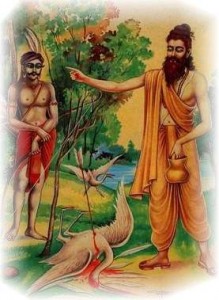Last week we took up the fascinating story of how a bandit named Ratnakara turns into a god-realized sage called Valmiki.
Many, many years passed since the sage Narada gave the name “Valmiki” to Ratnakara. The name and fame of the God-realized sage Valmiki had now spread. He established a hermitage by the banks of a river and had many disciples. One day he set out to have a bath in a nearby stream. The steam was sparkling peacefully and its waters crystal clear. Valmiki noticed two birds chirping happily on a branch above. Valmiki was happy to see such a happy couple. Suddenly the peace of the scene was shattered. One of the birds fell into the stream, shot through by the arrow of a hunter. The other bird, its mate, began to cry in agony. Distressed at the sudden turn of events, Valmiki looked around and saw the hunter who had shot the bird for food. In anger he denounced his actions by spontaneously uttering two lines in Sanskrit:
Peace you shall lose, eternal time to come.
Killed you have, bird in love’s passion!
Valmiki then turned around and returned to his hut, but the couple of lines that had found expression through his lips continued to haunt him. As he mulled over the meter of the lines he had a vision. In his vision the Lord asked him to narrate the story of Ram and Sita in poetic form using the same form and meter of the lines he had just recited.
Thus inspired, Valmiki sat down to compose the epic poem. He worked on the poem with the same sense of resolve that he felt when he sat down to meditate and an ant hill got built over him. So resolute he was in his effort and so perfect was his composition that since the ages few poet have come close to what Valmiki achieved. His epic poem is known as “Ramayana” consists of 24000 verses. Each verse was in the same format and had the same meter as the first two lines he had uttered in anger at the hunter. These two lines came to be known as the first “Shloka”. Henceforth most classical Eastern poems would be encapsulated in similar form of terse Shlokas composed in Sanskrit. The Ramayana predated by many, many, centuries Homer’s Iliad and was about 4 times longer.
Valmiki’s Ramayana became very popular and it spread far and wide. People found it easy to memorize it and teach it to their children and students. The Ramayana was memorized, transmitted, and communicated from generation to generation. This was thousands of years prior to the invention of writing or printing. What Valmiki had done was in effect to create a new technology that allowed the preservation and transmission of information. This technology was no different in its revolutionary impact on human progress than was the invention of writing, printing, or the creation of the internet.
Till now humans had to discover and rediscover things over and over again as information remained localized and prone to be lost in the face of famine, flood, war, and disease. Now all of a sudden a new technology was created which changed all this. Soon Shlokas were composed for preserving all kinds of knowledge from astrology, mathematics, metallurgy, medicine, agriculture, botany, etc., to spirituality and religion. A collection of related Shlokas on a single topic was known as a Sutra. Soon there were hundreds of Sutras on every imaginable topic that encapsulated all human knowledge. The Indian sub-continent was connected by trade to Africa, Middle-east, Central Asia, Mediterranean, and the Far-East. Most useful knowledge from different human habitations soon became encoded in this form and hence its preservation was assured. Knowledge was imported into the Indian sub-continent, absorbed and preserved, and repeatedly re-exported out till it finally took hold in various centers of civilizations around the world.
These sutras were living documents that were constantly updated and revised as new knowledge became available. It is hence nearly impossible to determine when the Sutras were first composed. But it is quite likely that Valmiki lived at least between 7000 to 10,000 years ago, if not earlier. No matter how long ago Valmiki lived, we can still be assured that the information age that he set in motion is responsible for the modern world we find ourselves in today.
This concludes the two part series. The first part is: A Bandit Turns Yogi
You may also like: The End Of Suffering

